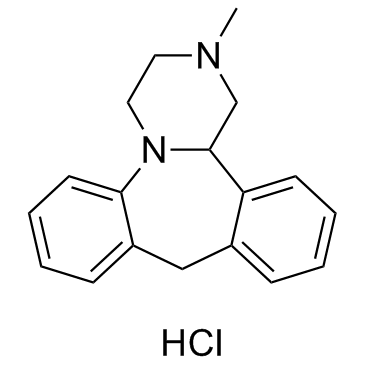21535-47-7
| Name | Mianserin Hydrochloride |
|---|---|
| Synonyms |
Tolvon
2-Methyl-1,2,3,4,10,14b-hexahydrodibenzo[c,f]pyrazino[1,2-a]azepine hydrochloride (1:1) EINECS 244-426-7 1,2,3,4,10,14b-Hexahydro-2-methyl-dibenzo[c,f]pyrazino[1,2-a]azepine hydrochloride Mianserin HCl Bolvidon Athymil Dibenzo[c,f]pyrazino[1,2-a]azepine, 1,2,3,4,10,14b-hexahydro-2-methyl-, hydrochloride (1:1) MFCD00055072 Mianserin hydrochloride Norval 1,2,3,4,10,14b-Hexahydro-2-methyldibenzo[c,f]pyrazino[1,2-a]azepine Hydrochloride Tetramide Mianserin (hydrochloride) |
| Description | Mianserin hydrochloride is a H1 receptor inverse agonist and is a psychoactive agent of the tetracyclic antidepressant.Target: H1 receptorMianserin is a psychoactive drug of the tetracyclic antidepressant (TeCA) therapeutic family. It is classified as a noradrenergic and specific serotonergic antidepressant (NaSSA) and has antidepressant, anxiolytic (anti-anxiety), hypnotic (sedating), antiemetic (nausea and vomiting-attenuating), orexigenic (appetite-stimulating), and antihistamine effects. It is not approved for use in the US, but its analogue, mirtazapine, is. Mianserin was the first antidepressant to reach the UK market that was less dangerous than the tricyclic antidepressants in overdose.Mianserin is an antagonist/inverse agonist of the H1, 5-HT1D, 5-HT2A, 5-HT2B, 5-HT2C, 5-HT3, 5-HT6, 5-HT7, α1-adrenergic, and α2-adrenergic receptors, and also inhibits the reuptake of norepinephrine. As a high affinity H1 receptor inverse agonist, mianserin has strong antihistamine effects (sedation, weight gain, etc.). Contrarily, it has negligible affinity for the mACh receptors, and thus lacks any anticholinergic properties. It was recently found to be a potent kappa opioid receptor agonist. In addition, mianserin also appears to be a potent antagonist of the neuronal octopamine receptor. What implications this may have on mood are currently unknown, however octopamine has been implicated in the regulation of sleep, appetite and insulin production and therefore may theoretically contribute to the overall side effect profile of mianserin. |
|---|---|
| Related Catalog | |
| References |
| Density | 1.18 g/cm3 |
|---|---|
| Boiling Point | 411.3ºC at 760 mmHg |
| Melting Point | >230ºC (dec.) |
| Molecular Formula | C18H21ClN2 |
| Molecular Weight | 300.826 |
| Flash Point | 186.1ºC |
| Exact Mass | 300.139313 |
| PSA | 6.48000 |
| LogP | 3.88880 |
| Vapour Pressure | 5.65E-07mmHg at 25°C |
| Water Solubility | H2O: 3.4 mg/mL |
CHEMICAL IDENTIFICATION
HEALTH HAZARD DATAACUTE TOXICITY DATA
MUTATION DATA
|
| Symbol |

GHS07 |
|---|---|
| Signal Word | Warning |
| Hazard Statements | H302 |
| Precautionary Statements | P301 + P312 + P330 |
| Personal Protective Equipment | dust mask type N95 (US);Eyeshields;Gloves |
| Hazard Codes | Xi:Irritant; |
| Risk Phrases | R22 |
| Safety Phrases | S22 |
| RIDADR | 3249 |
| WGK Germany | 3 |
| RTECS | HP8780000 |
| Packaging Group | III |
| Hazard Class | 6.1(b) |
| HS Code | 2933990090 |
| Precursor 0 | |
|---|---|
| DownStream 1 | |
| HS Code | 2933990090 |
|---|---|
| Summary | 2933990090. heterocyclic compounds with nitrogen hetero-atom(s) only. VAT:17.0%. Tax rebate rate:13.0%. . MFN tariff:6.5%. General tariff:20.0% |



